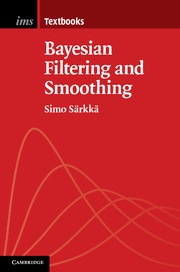Book contents
- Frontmatter
- Contents
- Preface
- Symbols and abbreviations
- 1 What are Bayesian filtering and smoothing?
- 2 Bayesian inference
- 3 Batch and recursive Bayesian estimation
- 4 Bayesian filtering equations and exact solutions
- 5 Extended and unscented Kalman filtering
- 6 General Gaussion filtering
- 7 Particle filtering
- 8 Bayesian smoothing equations and exact solutions
- 9 Extended and unscented smoothing
- 10 General Gaussian smoothing
- 11 Particle smoothing
- 12 Parameter estimation
- 13 Epilogue
- Appendix Additional material
- References
- Index
1 - What are Bayesian filtering and smoothing?
Published online by Cambridge University Press: 05 June 2014
- Frontmatter
- Contents
- Preface
- Symbols and abbreviations
- 1 What are Bayesian filtering and smoothing?
- 2 Bayesian inference
- 3 Batch and recursive Bayesian estimation
- 4 Bayesian filtering equations and exact solutions
- 5 Extended and unscented Kalman filtering
- 6 General Gaussion filtering
- 7 Particle filtering
- 8 Bayesian smoothing equations and exact solutions
- 9 Extended and unscented smoothing
- 10 General Gaussian smoothing
- 11 Particle smoothing
- 12 Parameter estimation
- 13 Epilogue
- Appendix Additional material
- References
- Index
Summary
The term optimal filtering traditionally refers to a class of methods that can be used for estimating the state of a time-varying system which is indirectly observed through noisy measurements. The term optimal in this context refers to statistical optimality. Bayesian filtering refers to the Bayesian way of formulating optimal filtering. In this book we use these terms interchangeably and always mean Bayesian filtering.
In optimal, Bayesian, and Bayesian optimal filtering the state of the system refers to the collection of dynamic variables such as position, velocity, orientation, and angular velocity, which fully describe the system. The noise in the measurements means that they are uncertain; even if we knew the true system state the measurements would not be deterministic functions of the state, but would have a distribution of possible values. The time evolution of the state is modeled as a dynamic system which is perturbed by a certain process noise. This noise is used for modeling the uncertainties in the system dynamics. In most cases the system is not truly stochastic, but stochasticity is used for representing the model uncertainties.
Bayesian smoothing (or optimal smoothing) is often considered to be a class of methods within the field of Bayesian filtering. While Bayesian filters in their basic form only compute estimates of the current state of the system given the history of measurements, Bayesian smoothers can be used to reconstruct states that happened before the current time.
- Type
- Chapter
- Information
- Bayesian Filtering and Smoothing , pp. 1 - 16Publisher: Cambridge University PressPrint publication year: 2013
- 6
- Cited by

